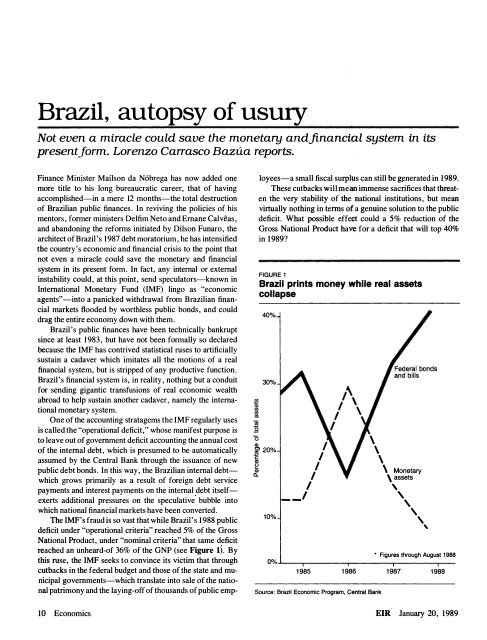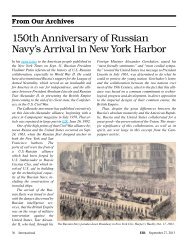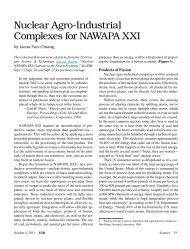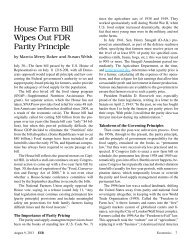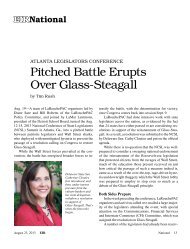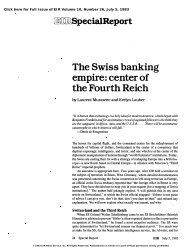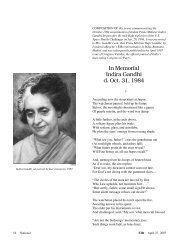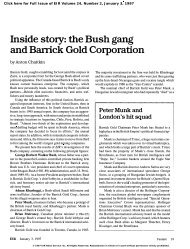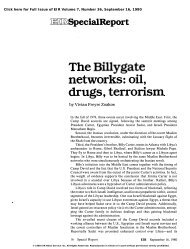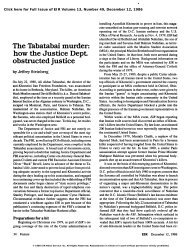View Full Issue - Executive Intelligence Review
View Full Issue - Executive Intelligence Review
View Full Issue - Executive Intelligence Review
You also want an ePaper? Increase the reach of your titles
YUMPU automatically turns print PDFs into web optimized ePapers that Google loves.
Brazil, autopsy of usuty<br />
Not even a miracle could save the monetary andfinancial system in its<br />
presentJorm. Lorenzo Carrasco Bazua reports.<br />
Finance Minister Maflson da Nobrega has now added one<br />
more title to his long bureaucratic career, that of having<br />
accomplished-in a mere 12 months-the total destruction<br />
of Brazilian public finances. In reviving the policies of his<br />
mentors , former ministers Delfim Neto and Ernane Calveas,<br />
and abandoning the reforms initiated by Dilson Funaro, the<br />
architect of Brazil's 1987 debt moratorium, he has intensified<br />
the country's economic and financial crisis to the point that<br />
not even a miracle could save the monetary and financial<br />
system in its present form. In fact, any internal or external<br />
instability could, at this point, send speculators-known in<br />
International Monetary Fund (lMF) lingo as "economic<br />
agents"-into a panicked withdrawal from Brazilian financial<br />
markets flooded by worthless public bonds, and could<br />
drag the entire economy down with them.<br />
Brazil's public finances have been technically bankrupt<br />
since at least 1983, but have not been formally so declared<br />
because the IMF has contrived statistical ruses to artificially<br />
sustain a cadaver which imitates all the motions of a real<br />
financial system, but is stripped of any productive function.<br />
Brazil's financial system is, in reality, nothing but a conduit<br />
for sending gigantic transfusions of real economic wealth<br />
abroad to help sustain another cadaver, namely the international<br />
monetary system.<br />
One of the accounting stratagems the IMF regularly uses<br />
is called the "operational deficit," whose manifest purpose is<br />
to leave out of government deficit accounting the annual cost<br />
of the internal debt, which is presumed to be automatically<br />
assumed by the Central Bank through the issuance of new<br />
public debt bonds. In this way, the Brazilian internal debtwhich<br />
grows primarily as a result of foreign debt service<br />
payments and interest payments on the internal debt itselfexerts<br />
additional pressures on the speCUlative bubble into<br />
which national financial markets have been converted.<br />
The IMF's fraud is so vast that while Brazil's 1988 public<br />
deficit under "operational criteria" reached 5% of the Gross<br />
National Product, under "nominal criteria" that same deficit<br />
reached an unheard-of 36% of the GNP (see Figure 1). By<br />
this ruse, the IMF seeks to convince its victim that through<br />
cutbacks in the federal budget and those of the state and municipal<br />
governments-which translate into sale of the national<br />
patrimony and the laying-off of thousands of public emp-<br />
10 Economics<br />
loyees-a small fiscal surplus can still be generated in 1989.<br />
These cutbacks will mean immense sacrifices that threaten<br />
the very stability of the national institutions, but mean<br />
virtually nothing in terms of a genuine solution to the public<br />
deficit. What possible effe¢t could a 5% reduction of the<br />
Gross National Product have for a deficit that will top 40%<br />
in 1989?<br />
FIGURE 1<br />
Brazil prints money while real assets<br />
collapse<br />
40%<br />
30%<br />
10%<br />
__ I<br />
,<br />
,<br />
,<br />
,<br />
,<br />
\<br />
\<br />
\<br />
\ Monetary<br />
\ assets<br />
,<br />
, , , , ,<br />
• Figures through August 1988<br />
O%�--�- -- -- -- --r- -- -- -- -�- -- -- -- -�- -<br />
1985 1986 1987 1988<br />
Source: Brazil Economic Program, Central Bank<br />
EIR January 20, 1989


